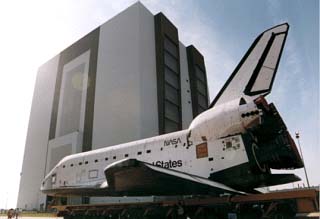


During the Shuttle-Mir Program, NASA's fleet of space shuttle orbiters included Columbia, Discovery, Atlantis, and Endeavour.
Columbia (OV-102), the first of NASA's orbiter fleet, was delivered to Kennedy Space Center in March 1979. Columbia initiated the Space Shuttle flight program when it lifted off Pad A in the Launch Complex 39 area at Kennedy Space Center on April 12, 1981. It proved the operational concept of a winged, reusable spaceship by successfully completing the Orbital Flight Test Program - missions STS-1 through 4. Columbia is named after a small sailing vessel that operated out of Boston in 1792 and explored the mouth of the Columbia River. One of the first ships of the U.S. Navy to circumnavigate the globe was named Columbia. The command module for the Apollo 11 lunar mission was also named Columbia.
Discovery (OV-103), the third of NASA's fleet of reusable, winged spaceships, arrived at Kennedy Space Center in November 1983. It was launched on its first mission, flight 41-D, on August 30, 1984. Discovery flew the "Near Mir" STS-63 mission and the last mission to Mir, STS-91. Discovery is named for two famous sailing ships; one sailed by Henry Hudson in 1610-11 to search for a northwest passage between the Atlantic and Pacific Oceans, and the other by James Cook on a voyage during which he discovered the Hawaiian Islands.
Atlantis (OV-104) was delivered to Kennedy Space Center in April 1985. It lifted off on its maiden voyage on October 3, 1985, on mission 51-J, the second dedicated Department of Defense flight. Atlantis flew to Mir on missions STS-71 (first docking), STS-74, STS-76, STS-79, STS-81, STS-84, and STS-86. Atlantis is named after a two-masted sailing ship that was operated for the Woods Hole Oceanographic Institute from 1930 to 1966.
Endeavour (OV-105) After the explosion and loss of the space shuttle Challenger, shortly after lift-off on January 28, 1986, authorization to construct the fifth orbiter as a replacement for Challenger was granted by Congress on August 1, 1987. Endeavour first arrived at KSC's Shuttle Landing Facility May 7,1991, atop NASA's new Shuttle Carrier Aircraft (NASA 911). Its first launch was for shuttle mission STS-49, on May 7, 1992. Endeavour flew to Mir on the STS-89 mission. Endeavour is named after the first ship commanded by 18th century British explorer James Cook. On its maiden voyage in 1788, Cook sailed into the South Pacific and around Tahiti to observe the passage of Venus between the Earth and the Sun. During another leg of the journey, Cook discovered New Zealand, surveyed Australia and navigated the Great Barrier Reef.
Related Links:
Spacecraft
Space Shuttle Orbiters
Space Shuttle Sub-Systems
Space Shuttle Orbiters
Space Shuttle Components
A Typical Shuttle Mission
Space Shuttle Life
Development History of Space
Shuttle
Shuttle
Diagrams
![]()
|
|
Curator:
Kim Dismukes Responsible NASA Official: John Ira Petty |
.gif)